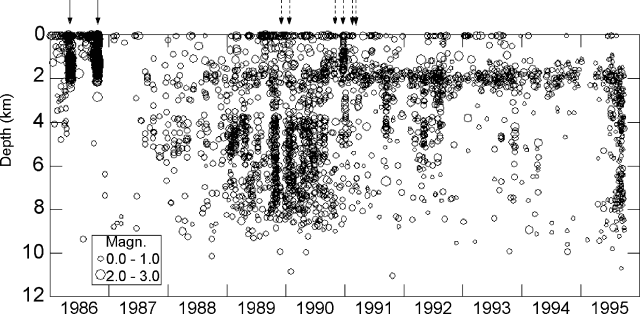Report on St. Helens (United States) — September 1995
Bulletin of the Global Volcanism Network, vol. 20, no. 9 (September 1995)
Managing Editor: Richard Wunderman.
St. Helens (United States) Steady increase in seismicity through 1995
Please cite this report as:
Global Volcanism Program, 1995. Report on St. Helens (United States) (Wunderman, R., ed.). Bulletin of the Global Volcanism Network, 20:9. Smithsonian Institution. https://doi.org/10.5479/si.GVP.BGVN199509-321050
St. Helens
United States
46.2°N, 122.18°W; summit elev. 2549 m
All times are local (unless otherwise noted)
No explosions or gas-and-ash emissions occurred from the lava dome between 1 January and 30 September 1995. Seismic activity was still low, but the number of small-magnitude (M
 |
Figure 44. Seismicity at Mount St. Helens, January 1986-September 1995. A high concentration of earthquake activity at |
This same zone of seismic activity became active in late 1987, about 2 years before the 1989-91 steam explosions began, and it presumably marks the approximate location of the magma conduit system. Those relatively small explosions hurled dome rocks as large as 30-40 cm in diameter at least 800 m from the dome and produced ash plumes as high as ~6 km above sea level. Detailed study of the 1987-91 seismicity and the 1989-91 explosions suggests that both occurred in response to increased pressure in the conduit system.
One possible cause for the pressure increase is that volcanic gas (primarily water vapor) became concentrated along the conduit system as a consequence of the progressive cooling and crystallization of magma. This increased pressure would likely lead to increased rock fracturing immediately surrounding the conduit system, as well as to intermittent sudden gas release. In addition, downward growth of cracks and fractures in the dome during and immediately after periods of intense precipitation could trigger gas explosions when such fractures intersect pressurized areas; many but not all of the 1989-91 explosions followed periods of heavy rainfall. Another possible cause for the pressure increase is intrusion of new magma into the lower depths of the conduit system. There is no evidence, however, that any magma has approached the surface during 1995. Regardless of the cause, it seems likely that the change in seismicity reflects a renewed increase in pressure along the magma conduit system.
Because the 1989-91 steam explosions were not preceded by any specific short-term warning signs, the similarity of the current seismicity raises concerns that future small dome explosions could occur without additional warning. Experience with the 1989-91 explosions, as well as explosions during the years of dome growth, suggests that they would produce hazards primarily within the crater, to a lesser degree in the stream channels leading from the crater, and to an even smaller degree on the upper flanks of the volcano. These hazards could include the impact of ejected dome rocks and rapidly moving pyroclastic flows sweeping the crater floor. During the 5 February 1991 explosion, a small pyroclastic flow reached the N edge of the crater. Heat from a rock avalanche or pyroclastic flow could also generate a lahar in the crater and in channels leading from the crater. Also, gas explosions could generate dilute but visible ash plumes perhaps as high as 6 km above the volcano and light ashfall as far as ~160 km downwind.
Geological Summary. Prior to 1980, Mount St. Helens was a conical volcano sometimes known as the Fujisan of America. During the 1980 eruption the upper 400 m of the summit was removed by slope failure, leaving a 2 x 3.5 km breached crater now partially filled by a lava dome. There have been nine major eruptive periods beginning about 40-50,000 years ago, and it has been the most active volcano in the Cascade Range during the Holocene. Prior to 2,200 years ago, tephra, lava domes, and pyroclastic flows were erupted, forming the older edifice, but few lava flows extended beyond the base of the volcano. The modern edifice consists of basaltic as well as andesitic and dacitic products from summit and flank vents. Eruptions in the 19th century originated from the Goat Rocks area on the N flank, and were witnessed by early settlers.
Information Contacts: Dan Dzurisin, Cascades Volcano Observatory, U.S. Geological Survey, 5400 MacArthur Blvd., Vancouver, WA 98661 USA; Steve Malone, Geophysics Program, University of Washington, Seattle, WA 98195 USA. URL: https://volcanoes.usgs.gov/observatories/cvo/).

